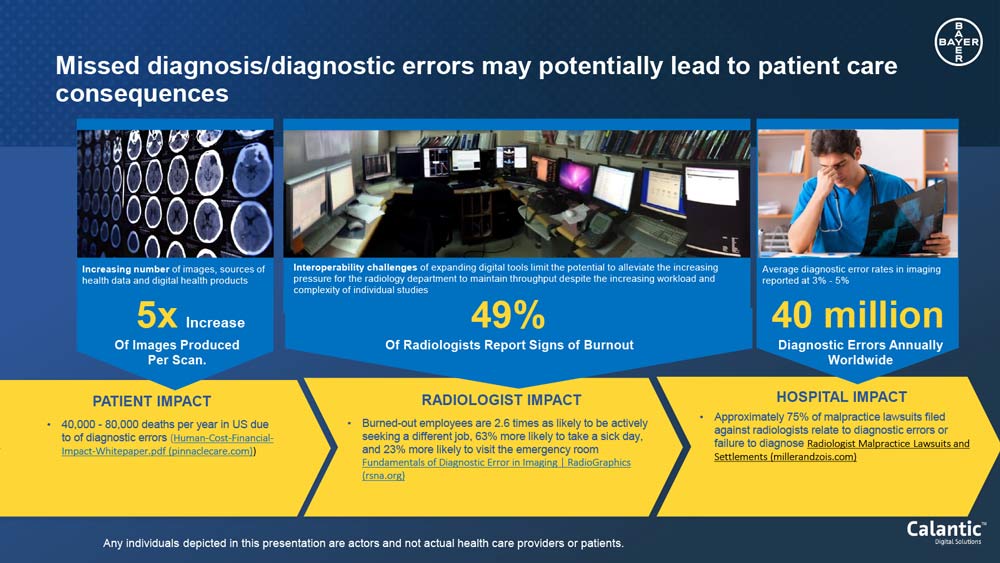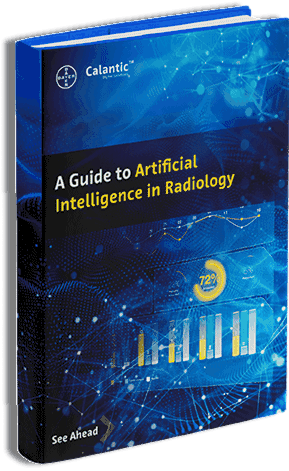AI applications have the potential to lift current burdens in radiology. But the willingness to pay for an application depends on who benefits from its use.
Speaker: Franziska Lobig, Bayer Pharmaceuticals, Digital Solutions
Currently, there are several hundreds of FDA-cleared and CE-marked radiology AI algorithms in the market - but only a small percentage of these get reimbursed in the US. Franziska Lobig, Bayer Pharmaceuticals, Digital Solutions, discussed the main parameters on how to assess the applications’ added value. Added value is an indispensable condition for future reimbursement.1
Baseline: Heavy Workload, Diagnostic Errors, Malpractice Lawsuits
The increasing number of medical images and the immense workload for radiology staff seriously impact patients, radiologists, and hospitals:
- Missed diagnosis and diagnostic errors lead to inappropriate treatment and delayed patient care with potentially drastic consequences. 40,000 – 80,000 deaths per year in US due to diagnostic errors have been estimated according to the whitepaper “The Human Cost and Financial Impact of Misdiagnosis” by pinnaclecare.com.3
- Almost half of all radiologists in the US shows signs of burnout. Burned-out employees are 2.6 times as likely to be actively seeking a different job, 63% more likely to take a sick day.
- With estimates of average diagnostic error rates ranging from 3% to 5%, there are approximately 40 million diagnostic errors involving imaging annually worldwide (Itri et al. 2018).2
- Approximately 75% of malpractice lawsuits filed against radiologists are related to diagnostic errors (“Radiologist Malpractice Lawsuits and Settlements” by millerandzois.com)4
AI Apps Value - Who Benefits the Most?1
Value in healthcare can be considered as patient health outcomes in relation to the cost of delivering these outcomes. The willingness to pay for an AI application depends on who benefits from its use.
Benefits can be improved by:
- Better patient outcomes : added value for the payer who wants to provide optimal care for reasonable cost
- Reducing costs of delivering the outcome: added value for the hospital
Clinical Utility for Application Reimbursement
Clinical utility is the evidentiary standard to evaluate solutions for reimbursement. It requires:
- Fundamental change in treatment – just increasing detection rates does not count
- Improved patient outcomes – change in treatment does not necessarily mean the patients live longer or have a better quality of life.
Both these aspects need to be proven when reimbursement of AI applications is being discussed.
Demonstrating Clinical Utility
Certain attributes of underlying diseases make it more likely to demonstrate the clinical utility of an AI application:
- High clinical burden of an indication – stroke counts for higher burden than a broken arm
- Unmet needs in current diagnostics or management – is there a problem that can be solved for the radiologist, such as inconsistent outcomes?
- Ability to impact clinical decision-making – this can only be addressed when multiple treatment options are available
- Short duration between imaging procedure, therapy decision, and outcome – you need all these parameters to generate robust clinical evidence
- Impact on healthcare resource utilization – for example, reducing the number of patients that need further diagnostic tests
References
1. F. Lobig et al. to pay or not to pay for artificial intelligence application in radiology. npj Digital Medicine (2023) 117
2. Itri JN et al. Fundamentals of Diagnostic Error in Imaging. RadioGraphics 2018;38(6)
https://doi.org/10.1148/rg.2018180021
3. The Human Cost and Financial Impact of Misdiagnosis
Whitepaper by pinnaclecare.com
https://www.pinnaclecare.com/wp-content/uploads/2018/02/PinnacleCare_WP_Misdiagnosis.pdf
4. Radiologist Malpractice Lawsuits and Settlements
Article by Miller & Zois Attorneys
https://www.millerandzois.com/malpractice-lawsuits-against-radiologists.html
Presentation Title: Driving AI Innovation to Assess Reimbursable Apps
November 2022
Author: mh/ktg







